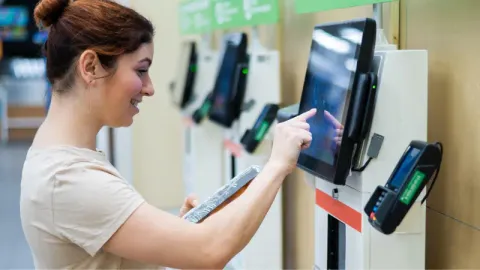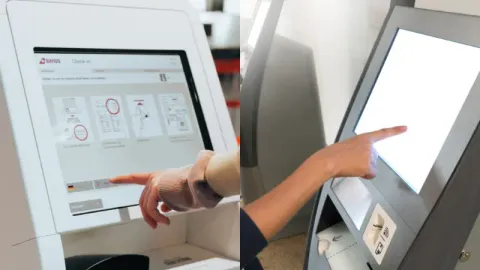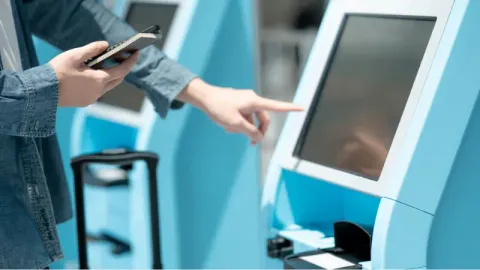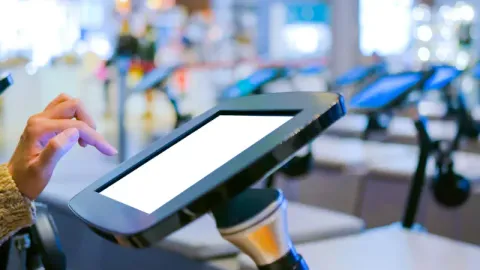If you’re running a business, you’ve probably felt the pressure of labor shortages and rising customer expectations. That’s why more companies are turning to self-service kiosks. Whether you manage a restaurant, a clinic, or a retail shop, you’ll need a self-service kiosk at some point.
This guide breaks down what self-service technology does, how to choose the proper setup, and what you need to know before making the switch. If you’re serious about modernizing your customer experience, read till the end.
How Self-Service Technology Works and Where It Fits Best

What Self-Service Really Means for Businesses
Self-service technology lets your customers complete tasks on their own, without staff involvement. That could mean ordering food, checking in for an appointment, making a payment, or getting product info.
The goal is to speed up service, cut wait times, and free up your team to focus on higher-value tasks.
It’s a system that runs smoothly in the background. It connects with your existing tools to make the process seamless for both customers and staff.
The Tools That Make It Work
Most self-service setups have two core parts:
- Hardware
- Touchscreens or tablet interfaces
- Card readers for payments
- Barcode scanners, printers, or ticket dispensers
- Software
- Point-of-sale (POS) or check-in systems
- Customer-facing interface (menus, forms, info)
- Backend integrations for payments, inventory, or scheduling
These two core parts work mutually, and the system runs on its own with minimal manual input.
Who’s Using Self-Service Tech Right Now
Self-service technology can serve almost all industries. Here’s how different businesses are already using it:
- Retail: Self-checkout kiosks, endless aisle product lookups
- Restaurants: Self-order stations, drive-thru touchscreens
- Healthcare: Patient check-in kiosks, bill payment systems
- Banking: ATMs, intelligent teller machines
- Hospitality: Hotel check-in/out kiosks, digital concierge screens
These tools are helping businesses serve more customers, faster, and with fewer bottlenecks.
What Self-Service Kiosks Are and How They Support Business Operations

Self-service kiosks help businesses grow without hiring more staff.
They let customers handle things on their own—like ordering or paying—while keeping everything updated in your system.
What Is a Self-Service Kiosk
A self-service kiosk is a digital terminal, usually touchscreen-based. It allows users to complete tasks such as placing orders, checking in, or making payments.
It’s a physical solution powered by both hardware and software to automate everyday transactions.
How a Self-Service Kiosk Functions
The process starts with the customer interacting through a user-friendly interface. Once they select a service or item, the kiosk routes that input through your system. Payments are processed on the spot, or the data is sent to billing software. All activity is synced with your POS, CRM, or other internal tools.
The goal is real-time, error-free task handling without slowing down your staff.
Types of Self-Service Kiosks
There are different types of self-service kiosks, each type with its own purpose and functionality.
- Retail Check-out Kiosks
Used for self-checkout and product lookups. These kiosks reduce wait times and help manage peak-hour traffic. Many also offer endless aisle capabilities by showing inventory beyond what’s in-store.
- Restaurant Self-order Kiosks
Restaurant kiosks allow customers to place orders, customize meals, and pay without waiting for a cashier. They help reduce ordering errors and keep service consistent even during rush periods.
- Healthcare Kiosks
Used for patient check-in, form updates, and bill payments. These reduce front desk congestion and support HIPAA-compliant data handling.
- Banking Kiosks
Handle ATM functions, innovative teller services, and document scanning. These kiosks reduce branch workload while maintaining full transaction functionality.
- Hospitality and Travel Kiosks
These kiosks allow guests to check in, print boarding passes, or get information. They cut down front desk lines and improve flow during peak check-in hours.
Benefits of Self-Service Technology for Customers and Businesses

Self-service kiosks change how customers interact with businesses and how operations are managed behind the scenes. Here’s a breakdown of the benefits on both sides.
How Self-Service Kiosks Improve the Customer Experience
- Faster Service with Less Friction
Kiosks help customers skip long lines and avoid unnecessary delays. The interface is direct and predictable…people get what they want quickly, without needing help from staff.
- 24/7 Availability
Customers can use your services anytime—even when staff aren’t around. This is especially useful for food spots, convenience stores, or travel locations where people still show up during late or off hours.
- More Personalized Interactions
Modern kiosks use data to tailor the experience. They can suggest add-ons, highlight frequent purchases, or display messages based on the customer’s behavior.
How Businesses Benefit from Self-Service Technology
- Reduced Labor Costs
By offloading routine tasks like ordering, check-in, or payments, kiosks help you reduce the need for front-line staffing. This is especially important in high-turnover or short-staffed environments.
- Higher Throughput During Peak Hours
Reports show that kiosks can cut queues by up to 50% and significantly increase order-taking capacity during peak hours. Multiple customers can use several kiosks at once. This reduces bottlenecks and keeps service moving without needing to scale headcount.
- Built-In Data and Analytics
Each interaction generates real-time data you can use to improve operations.
- Track customer behavior, buying patterns, and service times
- Optimize promotions, staffing, and layout based on insights
- Increased Sales Through Upselling
Unlike human cashiers, kiosks never forget to offer an upsell.
- Kiosks present suggested items at the right time in the order flow
- A Tillster study found a 20–30% increase in average ticket size through kiosks compared to counter orders.
Self-Service Kiosks vs Other Digital Self-Service Tools

Self-service kiosks are one of several ways businesses let customers complete tasks independently. But they’re not the only option. You also have mobile apps, AI chatbots, and customer portals…each with its own purpose and limitations.
If you choose the wrong tool, it can lead to a poor user experience or missed business goals. That’s why it’s important to know how kiosks compare with other options.
Comparing Self-Service Options
| Feature | Self-Service Kiosk | Mobile App | AI Chatbot | Web Portal |
|---|---|---|---|---|
| Hardware Required | Yes | No | No | No |
| Physical Presence | Yes (on-site) | No | No | No |
| Customer Engagement | High | Medium | High | Medium |
| Transaction Speed | Fast | Fast | Varies | Medium |
| Personalization | Moderate | High | Low | High |
| Best For | Retail, Restaurants, Travel | E-commerce, Loyalty Programs | Customer Service | Billing, Account Management |
| Staff Replacement | Partial | None | Minimal | None |
| Real-Time Service | Yes | Sometimes | Yes | No |
When Kiosks Make More Sense
Kiosks are the better choice when customers are on-site and need fast service, like checking in, ordering food, or paying bills. They reduce pressure on staff, shorten lines, and work well in high-traffic locations.
When to Choose Digital Tools Instead
Use mobile apps or web portals when users want to place orders, view accounts, or make changes remotely. Chatbots work best for handling basic questions or support steps, but not in-person tasks like payment or check-in.
How to Successfully Implement Self-Service Kiosks in Your Business
Rolling out self-service kiosks takes more than plugging in a screen. You need the right fit for your business model, reliable tech, and a user experience that works for both staff and customers. Here’s how to do it right from the start.

Step 1: Match the Kiosk to Your Business Use Case
Start by defining the problem you’re solving. Are you trying to reduce wait times, speed up ordering, or improve check-in?
Your use case will guide your kiosk choice.
- Retail: Look for self-checkout or endless aisle kiosks.
- Restaurants: Self-order kiosks improve speed and reduce order errors.
- Healthcare: Check-in and patient information kiosks reduce front desk load.
- Hospitality: Use kiosks for guest check-in or concierge services.
Only the right kiosk set-up will help you scale your business efficiently.
Step 2: Choose a Provider with Strong Technical Support
Don’t just look at hardware. Look at what’s under the hood.
A good provider should offer:
- Integration with your POS, CRM, or scheduling tools
- Real-time reporting and analytics
- Reliable hardware with responsive support
Names like Toast, NCR, and Diebold Nixdorf are common in the space…not endorsements, but well-known vendors to start your search.
Step 3: Design a Simple Interface and Train Your Team
The kiosk interface must be intuitive. Limit on-screen steps, use clear buttons, and test with real users. A confusing design can slow things down instead of speeding them up.
Staff training is just as necessary.
Teach employees how to assist customers, reset machines, and encourage adoption, especially during the first few weeks.
Some businesses pair kiosks with nearby staff support, giving customers help when needed while keeping most transactions self-directed.
Common Challenges (& Solutions) Of Implementing Self-Service Kiosk

Even the best kiosk systems face real-world obstacles. Here’s what to expect…and how to address it early.
Some Customers Resist Using Kiosks
Not everyone is ready to switch from human interaction to touchscreen menus. This is especially common in healthcare, hospitality, and with older users.
What to do:
Place signage near the kiosks to explain how they work. In the first few weeks, assign a staff member nearby to assist. Once customers try the kiosk once or twice, most will adopt it easily.
Technical Glitches Hurt Customer Flow
Kiosks are still hardware…and that means screens can freeze, printers can jam, or software may lag. These hiccups cause delays and frustrate customers.
What to do:
Use systems with remote monitoring and automated alerts. Schedule regular maintenance, and keep key replacement parts on-site. Choose providers with strong support response times.
Integration With Existing Systems Is Often a Headache
Without proper POS or CRM integration, your kiosk becomes an isolated tool. That breaks workflows and makes data hard to use.
What to do:
Choose vendors who specialize in integrations with your specific platforms. Ask for real implementation examples. Ensure their software can sync with your systems in real time.
The Future Trend Of Self-Service Technology

Self-service technology is evolving quickly. Businesses that adopt early often gain a competitive edge in customer loyalty and revenue.
Here are the key trends shaping the next generation of self-service tools.
AI-Powered Kiosks with Smarter Personalization
According to Olea Kiosks (Feb 2025), AI-powered kiosks are making customer experiences more personal. These smart kiosks can recognize repeat visitors using computer vision, remember their preferences, and offer loyalty rewards. This means quicker, more relevant service—perfect for retail and fast-food settings.
Voice-Activated and Touchless Interfaces
With growing concerns about hygiene and accessibility, more kiosks now support voice commands and gesture controls. These let customers complete tasks without touching a screen. This tech is ideal for healthcare, travel, or shared public spaces.
Augmented Reality for Product Exploration
Bridgewater Studio (May 2024) shows how AR is making kiosks more engaging. Some kiosks now let customers “try on” items virtually or view products in 3D. This is great for fashion, beauty, or tech products where hands-on demos are hard to offer.
Cloud-Connected Self-Service Ecosystems
Kiosk systems are shifting toward cloud-based infrastructure. This allows for faster updates, centralized data analytics, and real-time remote support across locations. It also makes scaling easier for multi-location businesses.
The common thread in all these trends? Smarter systems that blend digital convenience with deeper personalization…without adding operational complexity.
How to Choose the Right Self-Service Technology Partner

The kiosk provider you choose will directly impact your project’s success. Here’s what to look for before signing a contract.
Prioritize Seamless Integration
Your kiosk must connect with tools you already use. If it doesn’t integrate with your POS, CRM, or billing system, it’ll create more work…not less.
Look for providers who:
- Offer out-of-the-box integrations with your current software
- Can customize APIs or middleware if needed
- Have case studies or demos from your industry
Choose a Partner with Strong Post-Deployment Support
Kiosks need ongoing care…especially at scale. A good provider supports you after the system goes live.
Make sure they offer:
- Remote diagnostics and live technical support
- Software updates and security patches
- A dedicated point of contact or account manager
Don’t Compromise on Security and Compliance
Your provider should meet industry-specific standards. Look for built-in protections for both hardware and software.
Key standards include:
- HIPAA compliance for healthcare
- PCI-DSS compliance for payment systems
- End-to-end encryption and secure login access
Ask for Proof of Success
Don’t just take promises…ask for proof.
Request:
- Case studies from similar-sized businesses
- Live product demos or pilot access
- Client references you can speak to
FAQs About Self-Service Kiosks and Tools
Are self-service kiosks replacing employees?
No. But they reduce the need for staff to handle repetitive tasks. Kiosks allow your team to focus on higher-value interactions.
How much do self-service kiosks cost on average?
Prices range from $2,000 to $8,000+, depending on hardware, software, and customization needs. Ongoing costs may include support, software updates, and integrations.
What types of businesses benefit the most from kiosks?
Retail, restaurants, healthcare clinics, and hospitality venues see the highest impact. Kiosks are ideal for high-traffic environments where speed, consistency, and check-in/order flow matter.
What does maintenance for kiosks involve?
Basic maintenance includes software updates, hardware cleaning, and occasional part replacement. Choosing a vendor with remote diagnostics and quick-response support minimizes downtime.
Can I monitor and manage kiosks remotely?
Yes. Modern kiosks often come with cloud-based dashboards. These let you track usage, update content, and troubleshoot without being on-site, which is critical for multi-location businesses.
Final Thoughts: Is It Time to Go Self-Service?
If your customers expect speed, convenience, and control, self-service is a competitive necessity. Kiosks are front-line brand ambassadors that quietly shape your customer experience every day. Businesses that adopt early win loyalty, reduce churn, and scale smarter.
Start small, test smart, and let the data guide your rollout.
Let’s Build the Right Kiosk for You
Want to explore tailored self-service kiosk solutions for your business? Contact us for a custom consultation built around your industry needs.



